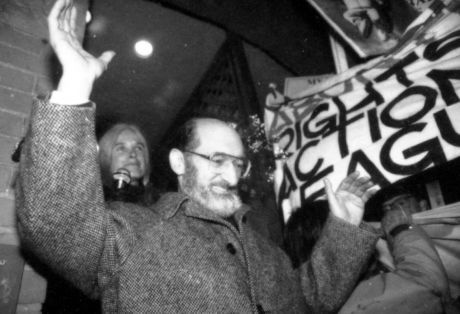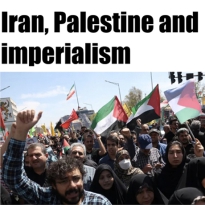Features
You are here
Reproductive justice and the campaign to overturn the federal abortion law

May 23, 2019
Reprinted from Abortion and the struggle for reproductive justice, a Resistance Press pamphlet (June 2014)
An historic battle took place in this country in the late twentieth century between the women’s movement, its allies and the Canadian state. A major victory was won when the Supreme Court of Canada overturned the federal abortion law in January of 1988. At the time the campaign was situated in the broader context of reproductive freedom. Abortion rights was seen as one of a number of demands that the women’s movement was struggling for in the fight for reproductive rights for all.1
Access to abortion before 1969
Before the law was struck down there was access to abortion, but it was a very privileged access. In 1969 legislation had been passed which allowed abortions to be performed if they took place in an approved or accredited hospital with the consent of a therapeutic abortion committee. The committee was made up of three doctors whose role was to determine whether the continuation of a pregnancy would impact on the physical or mental health of the woman. If they decided it did, the woman would be able to have an abortion. There was uneven interpretation of the law across the country and many hospitals did not establish committees. The law was unjust and denied women the right to make decisions over their reproductive health.
In practice it resulted in very inequitable access. Women with economic resources who could afford a private gynecologist or travel to the US or Montreal could get an abortion. Many racialized women, Indigenous women, working class, rural and young women did not have access. In spite of the claims that Canada had universal health care, there was a two-tiered system.
In Toronto, workers from the Immigrant Women’s Health Centre, the Birth Control and VD Information Centre and Hassle Free Clinic decided that they had to challenge a system that was denying abortions to many of those using their services. They spoke everyday with women who were being treated in a humiliating and degrading manner and made to leap though through hoops to access abortion. They felt strongly that the federal law was fundamentally flawed in that it took the decision out of the hands of women and was racist and class biased in its application. They and others formed the Ontario Coalition for Abortion Clinics (OCAC) in 1982.
The group thought long and hard about how best to change an increasingly desperate situation for so many women. We looked at the circumstance in the province of Quebec where CLSCs (community health centres) and the Centre de santé des femmes (women’s health centre) were providing abortions to women in their own communities. A lesson was learned from our sisters in Quebec and we modeled our campaign after theirs. The strategy was the combination of a doctor willing to challenge the law and a broad and representative movement willing to fight for the necessary changes.
A mass action, United Front approach
OCAC was a grass-roots, activist organization; a united front. The immediate objectives were to overturn the federal law and to legalize freestanding clinics providing medically insured abortions.
OCAC took a mass action approach. We did not leave the campaign to lawyers or to the lobbying of politicians. We believed that tens of thousands of women and men would come into the streets across the country to fight for women’s reproductive freedom. Groups took up the cause in every province and the Canadian Abortion Rights Action League fought side by side with us. Members and allies spoke to labour unions, to community organizations, on campuses and to faith communities. At the very start we won a resolution at the Ontario Federation of Labour convention supporting the campaign and individual unions followed suit. Women Working with Immigrant Women, a coalition of immigrant and racialized women’s organizations, was a strong supporter helping to organize meetings and active support in diverse communities. More and more groups and individuals joined the struggle. We began building a broad united front step by step and the popular support grew.
The membership set out to win full access to free abortion for all women. OCAC made clear in its organizing that it should be a fundamental right for all women to make the decision to terminate a pregnancy and that fully funded facilities must be in place to allow them to do so. It also felt that the movement needed an analysis that went much further. The group believed that women must also have the right to bear the children they choose to bear. This was a perspective that activists from the Immigrant Women’s Health Centre had put forward in earlier campaigns to remove barriers to abortion, sexual health and the support services required to continue a pregnancy.
Expanding the definition of ‘Choice’
We were aware of the limits of the notion of “choice”. Full access to free abortion, as significant an advance as that would be, does not guarantee that all women have choices over their lives or having children. The definition of “choice” was broadened in our organizing. OCAC stated that for all women to have real choices in our society they require safe and effective birth control services in their own languages and their own communities, decent jobs, paid parental leave, childcare, the right to live freely and openly regardless of their sexuality, an end to forced or coerced sterilization, employment equity, and of course, full access to free abortion. All were required if women were to have reproductive freedom.2
OCAC tried to ensure that the demand for abortion access was never seen in isolation but as one of a number of interdependent struggles. We tried to make this concrete by challenging the coerced sterilization that First Nations women, Black women and women with disabilities were facing. We held joint forums on the issues with women speaking about the injustices that they were experiencing. Healthcare workers said that therapeutic abortion committees sometimes refused abortions unless a woman agreed to be sterilized. We fought for child care as a woman’s right and campaigned against extra billing by doctors. AIDS activists spoke at our rallies outlining the pressures on HIV positive women to have abortions and tubal ligations. We worked very closely with the Midwives Collective fighting to have their services paid for by the state and available to all.
We believed that the choice to have a child can never be free in a society where many women earn so much less than men, in which quality childcare and affordable housing are not available, where inequity and discrimination are systemic. We found this reproductive rights perspective to be vital to the success of our organizing because it reflected the reality of women’s lives, broadened the base of the movement, and explicitly dealt with issues of class and race.
Defending the Morgentaler clinic in Toronto
OCAC worked with Dr. Henry Morgentaler and in 1983 he opened a clinic challenging the federal criminal code. The clinic became a symbol of women’s resistance to an unjust law. A long campaign against two levels of government and an organized anti-choice movement began.
Women were making appointments for abortions at the clinic knowing full well that the government viewed it to be “illegal”. They faced police surveillance and anti-choice harassment, standing up to both and demanding their right to abortion by defying the law. They were from many backgrounds including women without health cards, women from northern reserves, and those who could not speak English. They were the true heroines of the movement risking exposure and arrest, but they continued to come. Safe houses were established in the neighbourhood, and volunteer escorts accompanied women to the clinic protecting them from anti-choice harassment.
It did not take long before the facility was raided by the police and Dr’s Morgentaler, Scott and Smoling were arrested and the medical equipment seized. This was not unexpected and OCAC had been building broad support. We knew we were going to be in a long drawn out campaign. We had to change the balance of power in the country, and while the issue had to be in the courts because of the arrests, the critical task was mobilizing the strong support that we knew was there for women’s reproductive rights. Judges do not sit in isolation and we had to show that the law was unenforceable and make sure that a jury would not convict the doctors.
In linking struggles OCAC was able to build a wide campaign through demonstrations, marches and rallies in which thousands participated. Speakers from many communities spoke about the situation they were facing and why we had to work together to address the inequities that so many women were up against. We always tried to involve ourselves in movement building. Through our organizing we were able to broaden the participation of trade unionists, students, AIDS activists, people of colour, and immigrant women’s organizations in the campaign. We understood that without active participation and the support of thousands no change would occur. A strong united front was built.
After the raid we were caught in the courts for almost a year on a constitutional challenge through which the state tried to demobilize the movement. An Ontario Supreme Court Justice ruled that the federal abortion law was constitutional. He stated that the Charter of Rights and Freedoms protects only those rights that are spelled out in law or “rooted deeply in our traditions”. Well abortion is certainly rooted in women’s traditions. In the actual trial the jury unanimously rejected this by finding the doctors innocent. The government appealed the acquittal but the clinic reopened and the movement gained a tremendous momentum.
Building a mass movement to overturn the abortion law
The goal was to build a visible, mass movement which fought together for women’s reproductive freedom. The full message was often lost in the media presentations where most attention was given to the single issue of overturning the federal abortion law. We undoubtedly could have done it better. Achieving the best balance between short and long term goals, between the polemical value of the “choice” slogan and the constraints of such arguments was difficult sometimes. We didn’t always make the right decisions and were under tremendous pressure with so much at stake. There were many debates about the best way forward. Strategic complexities and dilemmas were not made easier in a movement that was constantly under direct attack from the state and the conservative right.3
OCAC was a voluntary organization raising money through donations, garage sales and benefits with one staff person at the height of the struggle. We openly debated questions, scheduling general membership meetings every two weeks and always tried to choose the course of action that would involve the largest number of people. At strategic junctures we advertised open public strategy meetings to involve everyone interested in determining our next steps. Many people who could not commit themselves to the organization in an ongoing way could attend.
When the Supreme Court finally overturned the existing abortion law it was through the strength of a broad and representative movement. It was a collective victory in which tens of thousands played an active role. The fact that OCAC understood that the state was not neutral and was not acting in the interests of women was critical to the success of our campaign. We believed that only a mass movement could change the balance of forces in the interest of all women. The united front strategy that was adopted was the key to the success.
There was a spontaneous demonstration of thousands of supporters outside the Morgentaler Clinic when the decision of the Supreme Court was announced. Women and men were dancing in the street! Similar rallies erupted across the country. Freestanding clinics were legalized in Ontario fully covered by the healthcare system and clinics began to open in other parts of the country as well. There were a number of facilities in Ontario that were able to provide abortions to women without health cards as a result of our organizing. This was a huge breakthrough for women without status.
Attempts to recriminalize abortion fail
It did not take long before the Conservative government in Ottawa began the process of introducing new legislation recriminalizing abortion. Because of the strong roots that had been developed a major campaign against a new law was launched. “Women are not Criminals” was the slogan. There was wide support from groups such as the National Organization of Immigrant and Visible Minority Women, the Canadian Labour Congress, the National Council of Jewish Women, the Federation des femmes du Québec, the United Church of Canada, the Canadian Medical Association, AIDS Action Now! and a large range of provincial and local organization across the country. There were national days of action and large numbers came out into the streets. Tragically during this period a young woman, Yvonne Jurewicz, died in Toronto of a self-induced abortion because she believed a legal procedure was not available.
During the campaign against the new law and for increased access, anti-choice forces began another assault. “Operation Rescue”, as they called it, started in Toronto in the fall of 1988 and attempted to blockade the entrance to the Morgentaler Clinic. They physically and verbally harassed women seeking abortions. OCAC organized defense of the clinics rejecting the argument that it should be left to the police to protect the facilities. Supporters would sometimes spend the night when we were given advance warning and would be outside waiting for them to arrive in the early morning. We would link arms chanting, “Racist, sexist, anti-gay, born again bigots go away”, “Campaign Life your name’s a lie. You don’t care if women die”, chants that reflected the politics of the campaign.
It would not be unusual for members of the United Steelworkers, the Black Women’s Coalition, AIDS Action Now!, Women Working with Immigrant Women, the Canadian Auto Workers, Aboriginal activists, Eco-Media, and the International Socialists to stand shoulder to shoulder defending the clinics. Because of the strong mobilization and community support, “Operation Rescue” was stopped. This speaks to the strength of the movement building strategy and the active alliances of the united front. Those who defended the services believed that the clinics were legal and accessible as a result of their collective struggle and were committed to defending them. This broad support created the political pressure to defeat the legislation in the Senate in 1991 after it narrowly passed in the House of Commons.
As Women Working with Immigrant Women (WWIW) said in a statement when the law was defeated; “Today we applaud the death of Bill C43 acknowledging that collective visible actions by many different constituencies led to its defeat. We strongly support OCAC’s position that the legal right to choose, as important as it is, is meaningless unless fully funded services exist to give every woman the opportunity to make that choice in her own language and her own community. WWIW will continue to work with OCAC to pressure the federal government to implement the Canada Health Act to ensure that every province provides full access to free abortion and to insist that the provinces provide this critical service with all the other demands that will ensure real choices in our lives…”4
Success and the ongoing struggle for full access
There are now over thirty freestanding clinics providing funded abortions across the country. Access is much wider than when the campaign began in the early eighties and sexual health services are more widely available, but the fight for reproductive justice is far from over. Prince Edward Island is still forcing women to go to the mainland to access abortions, and New Brunswick refuses to fund clinic procedures. Hospital amalgamations and health care cuts are reducing reproductive services in many areas. Women are still being harassed as they enter clinics. The Conservative Harper government initially refused to fund International Planned Parenthood and now gives money on the condition that it is allocated only in countries where abortion is illegal. There is no national childcare program. Equal pay for work of equal value is still a dream for many. Employment equity has not been implemented. Systemic racist and sexist discrimination still exists and many of the other services necessary for women to have real choices in their lives are not in place. Private members bills are regularly being introduced in the House of Commons to create barriers for women. To date all have been defeated.
Support for reproductive justice is still very strong across the country. While the overall strategic situation has changed, the lessons of the campaign that was waged still remain relevant. The principles and tactics that were used created a broad united front for reproductive rights. This overturned the federal abortion law and created a network of clinics making abortion much more accessible for women who were previously denied, initial and partial victories for sure, but still major gains for women’s reproductive freedom. We continue to fight for reforms, and the longer-term goal of women’s liberation for all will only occur with an end to capitalism and the creation of a society where exploitation and oppression are things of the past.
• A version of this article was published in Canadian Abortion Experiences: Voices of Choice
1. Carolyn Egan, “The Right to Choose” (Our Times, June 1985), 30.
2. Carolyn Egan, “The Right to Choose” (Our Times, June 1985), 30.
3. Ontario Coalition for Abortion Clinics, “Feminist Struggles and State Regulation: Controlling Women’s Reproductive Rights” (RFR/DRF Volume 17, Number 3, Fall 1998), 111.
4. Judy Vashti Persad, Salome Loucas, Women Working with Immigrant Women. Statement issued on the defeat of Bill C-43 (1991).
Section:










